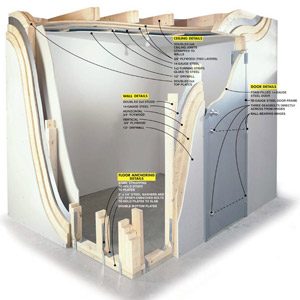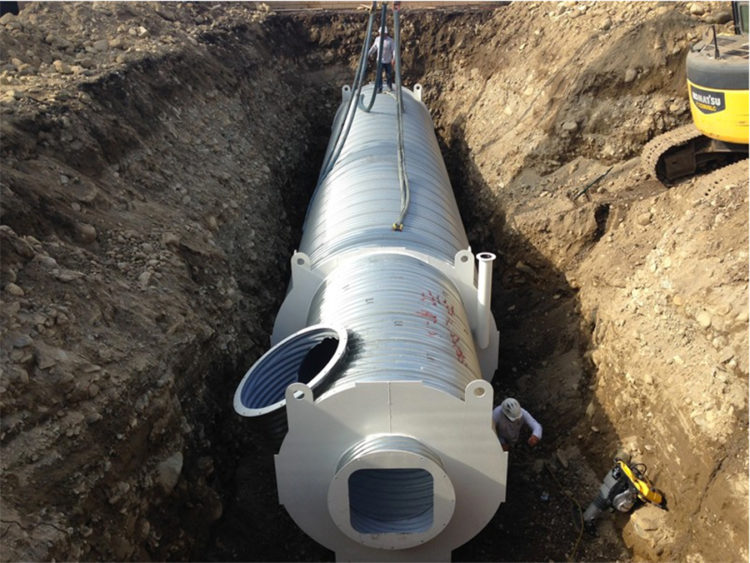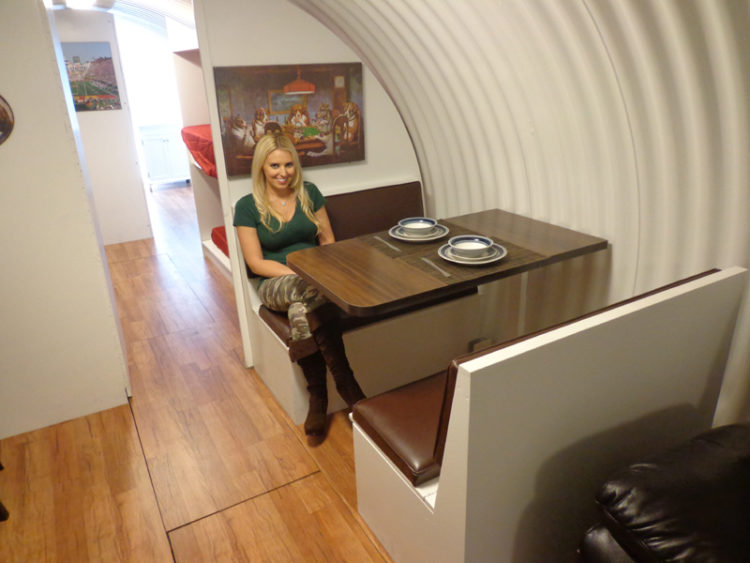Tornado Shelters Tiny Houses

This holiday season seemed to be full of severe weather causing devastation across the Midwest United States. The 12 tornadoes in Texas not only killed 11 people and caused billions of dollars in damage, but they destroyed several towns and thousands of homes. Tornado shelters are not always built as part
or hurricanes? Maybe you’ve been considering building a storm shelter, also known as a tornado room. It’s relatively easy to design a room to do double-duty as a storm shelter/storage room in a new home. But it’s not easy, and might not even be possible, to retrofit a storm shelter inside an existing home. An unfinished basement is a possible location, but even that wouldn’t be simple.
of a contemporary home, but homeowners can build their own shelters if they live in a tornado prone area.
Tornado and storm shelters run the gamut from a simple basement
or cement lined hole in the
Do you live in an area prone to ground outfitted with food, water and first-aid items. Some tornado shelters are much more luxurious and are actually tiny homes that can be placed underground. While many people may not be able to afford something this extravagant or want to live underground, these types of shelters can act as another home for several people in case primary homes are destroyed.
Some of the most interesting tornado shelters I found are Atlas Survival Shelters. These galvanized, corrugated pipe shelters claim to have a 200 year lifespan and feature full bedrooms, bathrooms, several hatches and come in several diameters and lengths of up to 50 feet. The prices for these shelters start at around $50,000
Other features of these shelters include under floor storage, full kitchens, air intake pipes and Swiss made air filtration systems, AC/DC wiring, and mud rooms. A prepper’s dream come true, these shelters can also have optional radiation detectors, camera surveillance, solar panels and 300 to 5,000 gallon water tanks.
But just about everyone has a yard and could use a garden shed, right? A stand-alone version of this storm shelter design is relatively easy to build for a moderately skilled DIYer. But this plan doesn’t include a roof, obviously a necessity for a yard shed. Instead of incorporating a roof into the design, you can build it exactly as shown here and add the roof of your choice, resting it on the top. It’s still important to anchor the roof to the building, but that’s easy to accomplish by adding hurricane clips connecting each piece of roof framing to the outer walls.
There are a few more advantages to a storm shelter in the yard. It’s a virtually impregnable vault for storing valuables—guns, documents, money, anything of value. And everything you store will be safe from a house fire as well. Since the storm shelter is completely lined with 14-gauge steel, it’s nearly fireproof.
A storm shelter is a super-strong safe room designed to withstand dangerous high winds, tornadoes and flying debris. You'll remain safe even if your house falls apart. We show you a type that you can build yourself.
- TIME
- COMPLEXITY
- COST
- Multi-day
- Moderate
- Over $500
How storm shelters or a safe room pays off
If you live in “Tornado Alley” in the panhandle of Texas or are worried about violent storms with high velocity winds, building storm shelters ( now called a “safe room”) should bring you a little more peace of mind. When faced with a severe storm, most people go to an interior room as you did or head for the cellar and hope for the best. Unfortunately, even those areas aren’t designed to withstand extreme winds and the wind-driven debris that comes with them. A drywalled, 2×4-framed room is no match for a 2×4 traveling at 100-plus miles an hour, even if it’s in the middle of a house. “Force 5” tornadoes or C5 hurricanes (the two most serious storms) can pack winds of more than 200 mph—enough to blow a well-built house right off its foundation. So a tornado shelter can pay off, especially if you live in a vulnerable high-wind zone area. (See Fig. A, below, to find the wind zone you live in.) A tornado shelter won’t cost a fortune, either. A little elbow grease and the building materials will all but guarantee your family’s injury-free survival in any storm that comes down the pike.
Keep in mind that a safe room can be more than just storm shelters. Within the house, the room can do double-duty as a storage room, walk-in closet, bath or pantry. Outside the house, it can function as a yard or storage shed. Wherever you put it, a bonus is that it’s a virtually impregnable vault for valuables, guns, documents and expensive equipment.
Example
Example
Safe room design options
All safe-room designs, even for rooms inside the house, are engineered to provide a room that’s completely independent of the house structure and bolted down to a concrete slab. In addition, the room has a tough, impact-resistant shell to protect occupants from the wind-blown debris that accounts for most storm fatalities and injuries.
A free booklet published by FEMA (Federal Emergency Management Agency) gives explicit construction information for building variations of safe rooms. It offers many designs to consider, depending on the design of your home and local building practices and materials.
We show a wood/steel design, but other equally effective designs use poured reinforced concrete, rein- forced concrete block, fiberglass and welded solid steel (you’d have to hire a contractor or buy a kit to construct these styles, however). Another option is a prebuilt one-piece steel or modular cast concrete unit that can be dropped into the ground or into a home under construction. Even if the house disintegrates around the safe room in the teeth of a tornado, you’ll be snug and safe inside (but scared to death!).
Safe rooms and storm tornado shelters are still embryonic in design, but the room we show below is the sturdiest, most DIY-friendly design we found. It’ll fit in most basements, large garages or even outside on a separate slab, for people who live in slab-on-grade homes or mobile homes. For outside locations, build the structure as shown and add a roof and siding.
Safe Room Design and Parts
Note: You can download this photo and enlarge it in the Additional Information below.
Key details of our design
Safe rooms or storm shelters can be built any size you want, as long as you build them with the specifications described in the FEMA booklet. This storm cellar room measures 7 x 8 ft., but it could just as easily be 4 x 4 ft. When you’re planning the size, keep in mind the available space, the number of people you expect to protect, the secondary purpose the room will serve and your budget.
The sandwich skin of the storm shelter’s walls and ceiling has two layers of 3/4-in. plywood oriented in opposite grain directions. The plywood absorbs most of the impact of flying objects, and a layer of 14-gauge steel on the “safe side” (interior side) of the room further blocks debris. The skin can be applied to either the inside or the outside of the studs as long as the steel sheeting faces inside the room.
When possible, install the sandwiched skin on the outside surface of studs. Construction will be easier because you’ll be able to run wire and install electrical boxes without cutting through steel. Plus, you’ll be able to fasten an optional cosmetic layer of drywall to the plywood on the outside and to the studs on the inside. We had to install the sandwich on the inside surfaces on the two walls facing the concrete block and on the ceiling because those areas were inaccessible from the outside. On the ceiling, we glued 1×2 furring strips to the interior-mounted steel to hold the drywall screws.
A steel door mounted in a steel frame with three deadbolts located opposite heavy-duty hinges lets only people and pets into the room, not door-busting debris. Steel and plywood sheathing is fastened with either 3-in. self-tapping screws, or 3-in. deck screws driven through pilot holes spaced every 6 in. All doubled framing members are nailed to each other with 10d nails spaced every 6 in. on each side.
Full-service lumberyards either carry or will special-order all the materials you’ll need to build this storm cellar room, except the 14-gauge steel sheets. Look under “Steel Distributors” in the Yellow Pages or online for a local supplier.









No comments:
Post a Comment